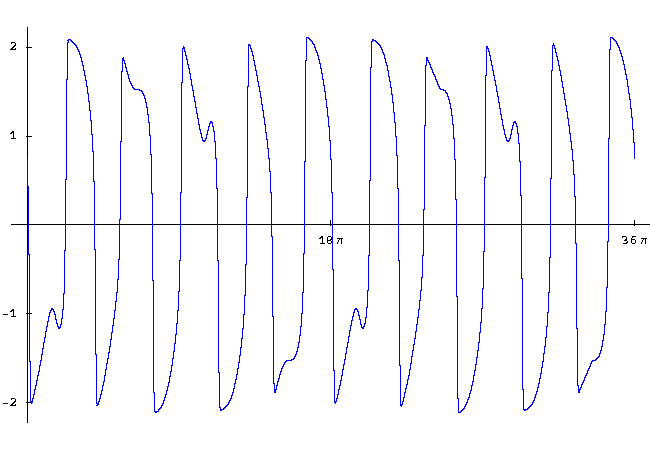
Due: Your report must be submitted by 10:00 a.m. on Friday, April 18.
Group project: Your group is limited to at most four members. Once a group begins work on the project, its membership cannot change. Consequently establishing your group must be your first step in this project. Each group will submit one report, and all members of the group will receive the same grade for this project.
Goals:
Parameter values: There are two parameter values k0 and b0 that are determined by the last (single) digits of your BU ID numbers. The parameter k0 is used with the damped forced harmonic oscillator and the parameter b0 is used with the forced van der Pol equation. The values of these two parameters are the same, but I have used different notation to emphasize the fact that their meanings are dramatically different. Use k0 = 5 + 0.1 a where a is the average (accurate to two decimal places) of the last digits of all members in the group. For example, if the last digits are 0, 1, 2, and 2, then a = 1.25 and k0 = 5.12. Likewise, b0 = 5.12.
Second-order equations: Using all of the methods that we have developed in this course, you should analyze and compare the long-term behavior of the solutions to two forced second-order equations.
The first equation (the forced harmonic oscillator)
is linear. Here b is the damping coefficient, k0 is the spring constant (based on your ID numbers), and w determines the frequency of the forcing. Describe how the long-term behavior of the solutions changes as the damping coefficient b and the forcing frequency w vary. Be as precise as possible.
The second equation is a
forced version of one of the nonlinear equations
where b0 is the parameter determined by your ID
numbers (see above). In particular, you should
search for periodic solutions to this forced equation for
values of e in the interval
Some history:
The nonlinear equation is called the forced van der Pol
equation. Van der Pol studied this equation as a model for a vacuum
tube triode circuit approximately 80 years ago. He and his colleague,
van der Mark, noted the existence of two stable periodic solutions
with different periods for certain values of the parameter e.
Their work inspired two English mathematicians, Mary Cartwright and
Even though the existence of these stable periodic solutions has been
known for almost 60 years, there are relatively few graphs of these
solutions in the literature (as far as I can tell). Here's
one
from a
paper of Littlewood published in 1963.
Here's one of period

Finding periodic solutions of a forced equation is more difficult than finding periodic solutions of autonomous equations. In the autonomous case, any solution curve that comes back to where it started in the phase plane corresponds to a periodic solution. Unfortunately, in the nonautonomous case, the vector field varies in time, and solution curves in the phase plane can cross.
It is a little tricky to use a computer to tell if you have found a
periodic solution, but for this equation you can take advantage of the
fact that the equation is periodic in t with period
2 pi. So if a solution goes for 2 pi units of time and
ends up back at the same initial condition, then the solution has to
be periodic. (Why? This point of view is discussed on
HPGSystemSolver can help you with your search, but don't use the default step size. For this differential equation, I recommend that you set the step size to 0.001.
Numerical simulation: For the forced van der Pol equation, you may want to use a new program called PMapVDP in conjunction with HPGSystemSolver. I have implemented an on-line version of the program using the Math Department's webMathematica site. It works fine, but only two users can run it at the same time. My guess is that this will not be a problem until the night before the project is due.
Your report: Your report should be no longer than four typewritten pages, and it should include a discussion of your results for the forced harmonic oscillator, your results for the forced van der Pol equation, and a comparison of the two sets of results. You may provide as many illustrations from the computer as you wish, but the relevance of each illustration to your report must be evident. (Please remember that, although one good illustration may be worth 1000 words, 1000 illustrations are worth nothing.) Please insert your illustrations at appropriate places in your report rather than attaching them to the end of the report.
Asking questions:
Questions related to the project will be answered at the
start of each lecture. Questions sent by email will also be
answered at the start of each lecture. Questions sent by
email after lecture on Wednesday,
Academic Conduct:
Your work and conduct in this course are governed by the
CAS Academic
Conduct Code. This code is designed to promote high standards of
academic honesty and integrity as well as fairness. A copy of the
code is available in